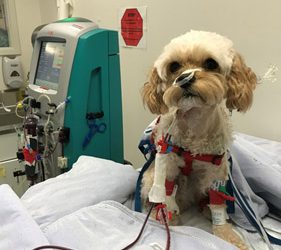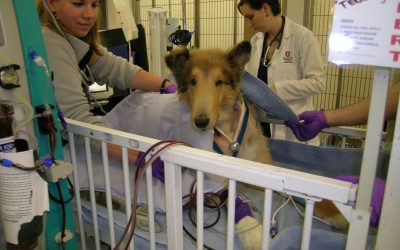Does Your Pet Need Dialysis?
Enter your location to find vets that offer dialysis in your area.
About Dialysis
Determine if your pet would benefit from one of these therapies
Start by asking your vet to talk to the nearest dialysis unit to decide whether dialysis is the right choice. Because dialysis and related treatments are intensive and generally expensive, we all want you to make an informed decision before arranging travel and transport and starting treatment.
Hemodialysis
Therapeutic Plasma Exchange
Charcoal Hemoperfusion
Hemodialysis uses a machine to replace the function of the kidneys. Blood is taken out of the patient through a two-sided catheter. The blood goes through the hemodialysis machine which cleans the blood, and the clean blood is returned to the patient through the other side of the catheter.
Therapeutic Plasma Exchange
Therapeutic Plasma Exchange (TPE) involves removing plasma from the patient, to remove substances in the plasma that are causing trouble. TPE can treat some immune diseases like immune-mediated hemolytic anemia or myasthenia gravis and certain toxicities.
Charcoal Hemoperfusion
If pets get into toxins or medications and there is no antidote, charcoal hemoperfusion may help remove those toxins from the blood. Blood is taken out of the patient, trickled over sterile charcoal which absorbs the toxins, and the clean blood is returned to the patient.
Frequently Asked Questions
What is Hemodialysis?
Hemodialysis is a method of treating kidney failure. One of the many jobs of the kidneys is to clear the blood of certain substances, which include normal waste products as well as certain drugs or even toxins, by extracting those substances from the blood and putting them in the urine. The urine is then eliminated from the body.
Hemodialysis uses a machine to replace the function of the kidneys. Blood is taken out of the patient through a two-sided catheter. The blood goes through the hemodialysis machine which cleans the blood, and the clean blood is returned to the patient through the other side of the catheter. Hemodialysis does not make the kidneys get better; it does the job of the kidneys so the patient can live long enough for the kidneys to heal if the kidneys failed because of a problem that can be reversed. Hemodialysis reliably makes the blood values better.
The hemodialysis schedule depends on the circumstances. In some units, treatments take 4-8 hours and may be performed daily for several days in a row, then decrease to every other day. In other units or with some extremely critical patients, treatment may be 24 hours a day for several days. In general, it can take two to four weeks for the kidneys to recover, and dialysis may be needed for that period of time.
Peritoneal dialysis is a different form of dialysis that cleans the blood by putting a saline solution in the belly using a special catheter, and then draining it out and repeating the process. I have not been tracking veterinary hospitals that provide this therapy.
What is Therapeutic Plasma Exchange?
The same machines used for hemodialysis for kidney disease can be used to treat other conditions. Therapeutic Plasma Exchange (TPE) involves removing plasma from the patient, to remove substances in the plasma that are causing trouble. Those substances include antibodies that are attacking the body (auto-immune diseases) and some toxins. After removing the “dirty” plasma, it is replaced with a combination of intravenous fluids and frozen plasma from the blood bank. TPE has been used successfully in treating myasthenia gravis crisis and certain toxicities. It is being used more and more to treat immune mediated hemolytic anemia, in which the body starts destroying its own red blood cells.
What is Charcoal Hemoperfusion?
Dogs and cats occasionally eat things they shouldn’t, like toxins or unattended medications. For some of these, the vet will try to get the patient to vomit up the substance before it gets absorbed, or have the patient eat activated charcoal to bind the substance and prevent it from being absorbed. If the substance has already been absorbed into the blood, there may be an antidote or supportive care to help. In other cases, these treatments are not effective. In that case, one option might be to expose the blood to sterile charcoal to help bind the substance present in the blood. Blood is taken out of the patient, trickled over charcoal, and the clean blood is returned to the patient. Depending on the circumstances, one treatment may be all that is needed. In other cases, a second treatment the following day may be recommended. For most toxicities, time is of the essence.
How do I determine if my pet would benefit from one of these therapies?
Start by asking your vet. These types of therapies are highly specialized, and the majority of veterinarians are not familiar with the details. We encourage your local vet to talk to the nearest dialysis unit to decide whether dialysis is the right choice. Because dialysis and related treatments are intensive and generally expensive, we all want you to make an informed decision before arranging travel and transport and starting treatment.
How do I get treatment for my pet?
There are about 50 veterinary hemodialysis units in the world (that I know about), with more coming soon. The goal of this website is to help you (and your vet) find a unit nearest you. Each unit will have different approaches. In general, you or your vet should contact the nearest unit to determine availability and suitability before embarking. Make sure that you find out the anticipated outcome, cost, and duration of treatment before making your decision. This may be done through a conversation with your local vet after consultation with the dialysis unit, or by talking to a member of the dialysis team. Once you decide to pursue therapy, it is helpful to let the dialysis unit know your anticipated arrival time. This lets the unit alert the dialysis team that is on-call.
What is the availability for each unit listed on this site?
While I try to keep this list current, I cannot promise that any unit will be accepting patients at any given time. You can help me keep this list accurate by letting me know of new units or units that are not accepting patients.
How do vets learn about dialysis?
Dialysis and related treatments involve highly specialized equipment and skills. Dialysis training may take several forms. A few veterinarians have done a fellowship in dialysis, where they spend one to three years training with an expert in dialysis, generally after completing a residency in internal medicine or critical care. Some vets have taken a 1.5 year course in dialysis provided by the leaders in the field. Graduates of this Hemodialysis Academy have learned the intricate details of dialysis and passed multiple exams. Some vets learned dialysis during their residency training. Others may have learned from a variety of other sources.
News & Media
Gentle treatment for high-risk patients
Little Teddy wasn’t eating well and then started vomiting. He went to his regular vet, who diagnosed kidney failure. He was referred to the regional specialty clinic, who hospitalized him for treatment. By the next day, that clinic recognized that his kidney disease...
A Collie with a Kidney Infection
Teddy is a 5 year old collie who is owned by a veterinary cardiologist. He developed acute kidney failure and jaundice and was hospitalized at her practice. Over the course of the next few days, he did not respond to standard treatments, and his urine output started...
Cleaning plasma to treat anemia
It all started with orange diarrhea. The following day, Rosie became lethargic, which was unusual for a 2-year-old Goldendoodle. She presented to her local veterinarian, who diagnosed her with immune-mediated hemolytic anemia (IMHA), which is a condition where the...
Gentle treatment for high-risk patients
Little Teddy wasn’t eating well and then started vomiting. He went to his regular vet, who diagnosed kidney failure. He was referred to the regional specialty clinic, who hospitalized him for treatment. By the next day, that clinic recognized that his kidney disease...
Veterinary Dialysis Providers
If you are veterinary unit that performs dialysis or another form of extracorporeal therapy, fill out this form to be listed. After you submit the form, I will confirm the details and post it to this site. If your unit is already listed, use the form to submit requests for changes and updates.



